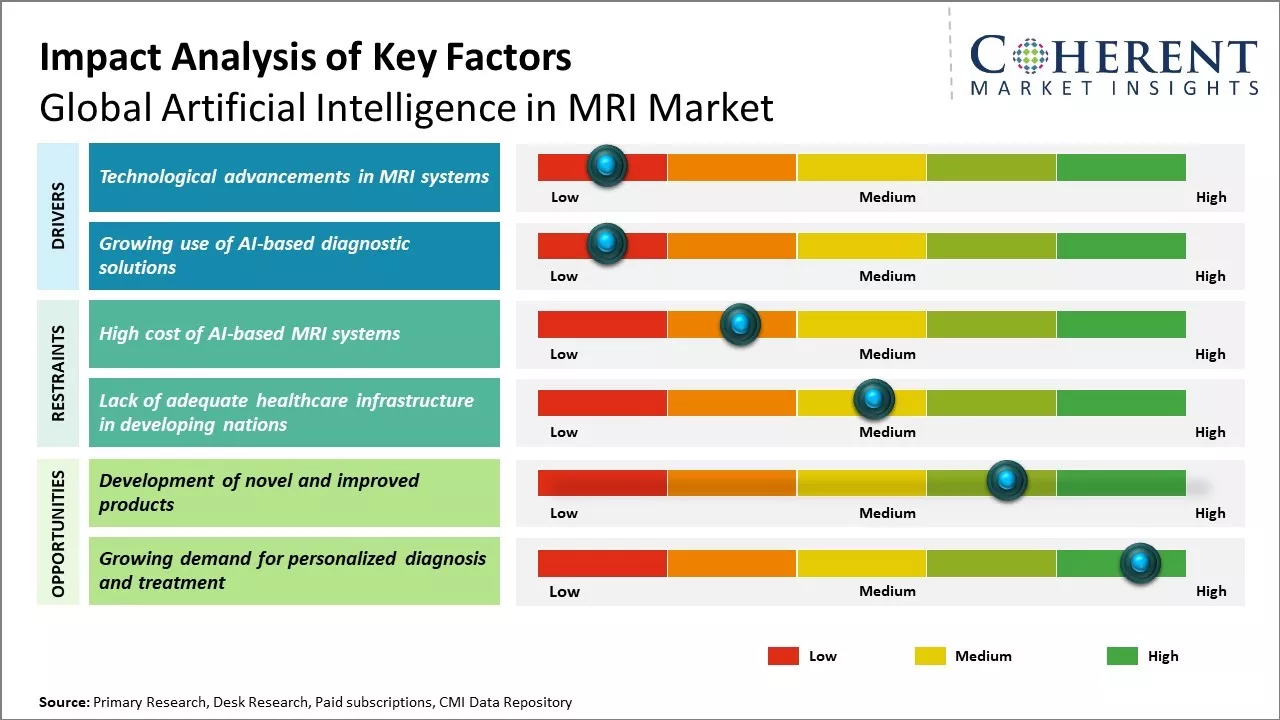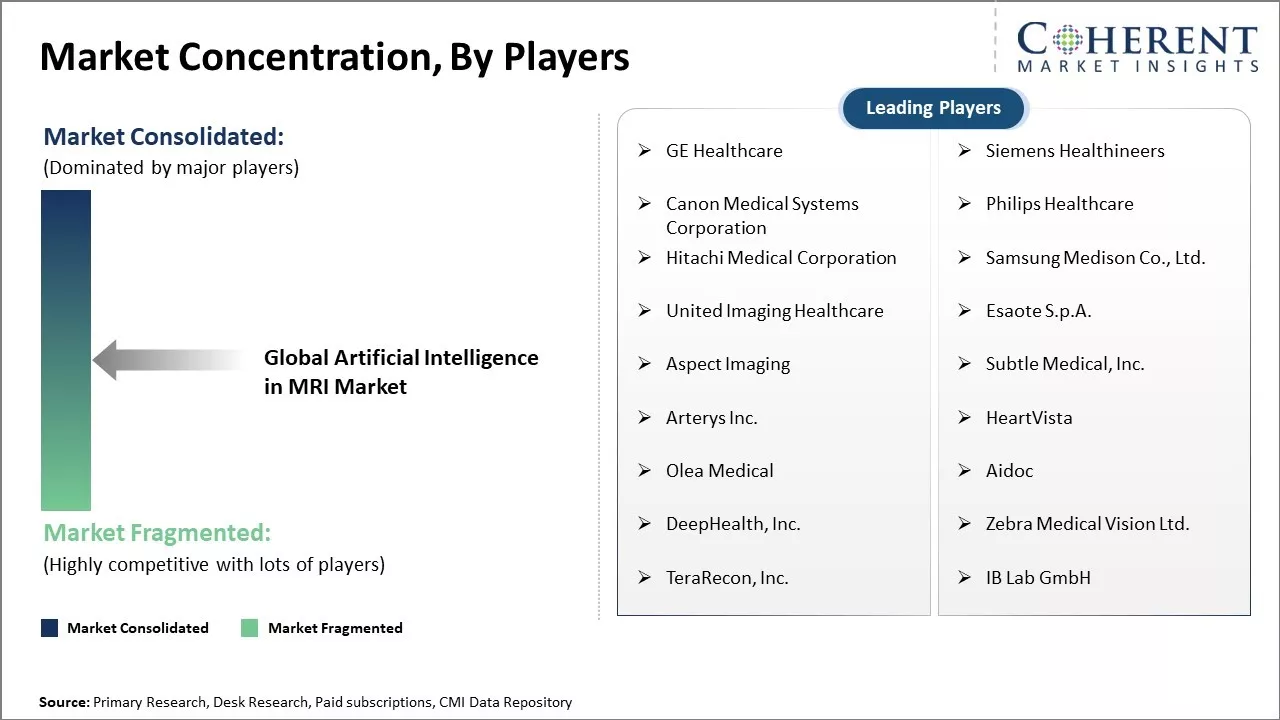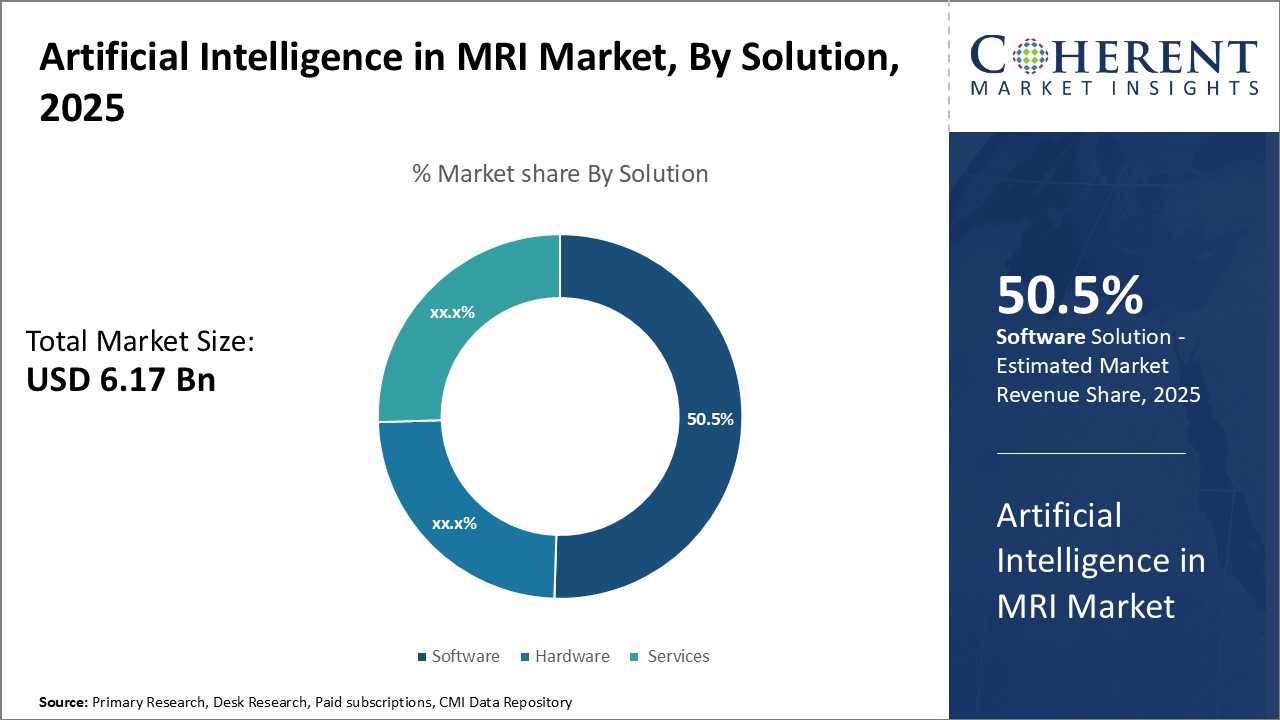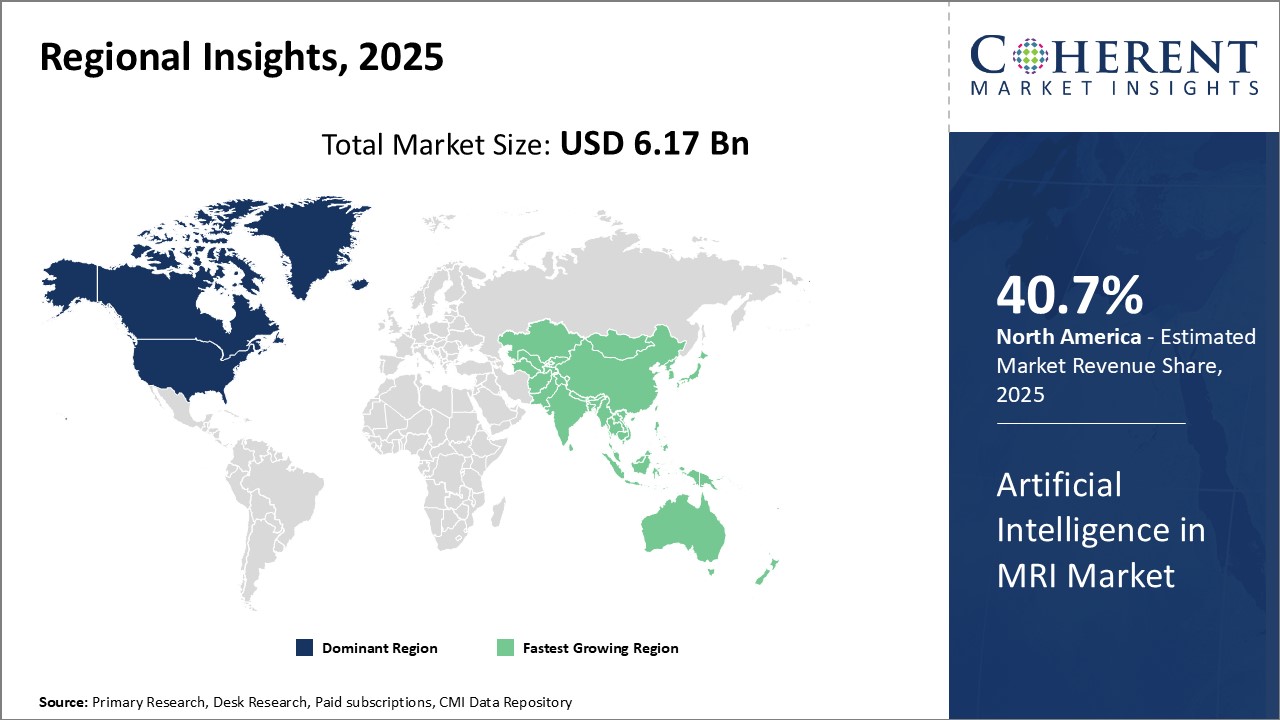The global artificial intelligence in MRI market is estimated to be valued at USD 6.17 Bn in 2025 and is expected to reach USD 9.46 Bn by 2032, exhibiting a compound annual growth rate (CAGR) of 6.3% from 2025 to 2032.

Discover market dynamics shaping the industry: Request sample copy
The artificial intelligence in MRI market is expected to witness a positive growth trend over the forecast period. Proactive government initiatives in favor of digital healthcare and growing adoption of AI-based solutions by healthcare providers worldwide are some key factors expected to drive the demand for AI-enabled MRI systems. In addition, the increasing popularity of precision medicine approach and the need for accurate diagnosis is further augmenting the incorporation of advanced AI capabilities in MRI imaging. The development of deep learning algorithms and availability of large imaging data are also supporting the market growth. However, lack of skilled workforce and concerns regarding data privacy and safety may slightly inhibit the market progression during the forecast years. Overall, the artificial intelligence in MRI market is poised for significant gains with growing reliance on advanced medical imaging solutions.
Technological advancements in MRI systems
Technological advancements in MRI systems are poised to revolutionize the global artificial intelligence in MRI market. MRIs have become more powerful and sophisticated over the years, producing high resolution scans and images that provide invaluable diagnostic information to radiologists and physicians. However, the complexity and volume of data generated by modern MRI machines has grown exponentially. Manually analyzing the extensive imaging studies has become very time consuming and laborious for medical professionals. This is where artificial intelligence is playing a transformative role. AI tools that utilize deep learning algorithms and neural networks are being developed to automatically read, interpret, and highlight areas of interest from MRI scans. This augments and enhances the diagnostic capabilities of radiologists. AI applications can detect subtle anomalies, quantify tissues and lesions, and compare a current scan to historical scans to identify any changes. They can perform these tasks much faster than humans by analyzing thousands of data points simultaneously. For example, an AI solution approved by the FDA in 2020 reduced MRI reading time from 15 minutes to just 45 seconds per scan. This represents a significant increase in productivity and efficiency for healthcare providers. As the data volumes and cognitive loads associated with advanced MRI continue growing exponentially, AI is expected to play an even greater role by assisting with primary diagnosis, monitoring disease progression, treatment responses and facilitating personalized care pathways. AI also helps increase the availability of specialized expertise to underserved regions by enabling general radiologists to supplement their skills. The global artificial intelligence in MRI market is estimated to register a CAGR of over 30% until 2025, according to projections by the World Health Organization. This rapid growth reflects increasing investments from MRI manufacturers and diagnostic centers looking to optimize workflows and diagnostic accuracy through cutting-edge AI applications.

Get actionable strategies to beat competition: Request sample copy
Growing use of AI-based diagnostic solutions
The use of artificial intelligence (AI) based diagnostic solutions is increasing rapidly in the global MRI market. AI is helping radiologists and healthcare providers extract more value from MRI scans by enhancing image quality, automating routine diagnosis, and enabling real-time clinical decision making. This is improving diagnostic accuracy and reducing reading time significantly. For example, algorithms developed by startups like Anthropic are automating tasks like lesion detection from brain MRIs for conditions like cancer, multiple sclerosis, etc. This allows radiologists to confirm detection in few minutes compared to manually examining hundreds of images. Some solutions are also automating MRI reporting by analyzing patterns in scans and generating preliminary radiology reports with important clinical findings highlighted. Such AI applications are reducing workload on overburdened radiologists and improving their productivity multi-fold. In the coming years, the adoption of advanced AI technologies like deep learning is projected to further accelerate. Models will become more sophisticated by training on growing volumes of MRI data from various healthcare providers as well as patients. This will enhance capabilities of AI solutions from the automated detection of new types of abnormalities to generating detailed radiology reports on par with human experts. It will also enable real-time augmented intelligence where AI will be used during scans to provide live assistance to radiologists.
Key Takeaways from Analyst:
The global artificial intelligence in MRI market holds significant growth potential driven by increasing investments in AI-based technologies by healthcare providers and researchers. MRI scans produce large amounts of complex unstructured data which AI is well-suited to analyze for insights. AI can help radiologists more accurately detect and diagnose medical conditions by automating routine tasks and leveraging huge volumes of historic patient data. This reduces errors and improves clinical outcomes. North America currently dominates due to extensive R&D and a favorable regulatory environment for AI-driven medical innovations. However, Asia Pacific is expected to emerge as the fastest growing region with increasing healthcare expenditures and massive patient pools.
Some challenges that may hinder the market growth include the lack of expert AI skillsets and high initial costs of setting up AI-enabled MRI systems. Integration of AI technologies with existing imaging infrastructures also presents technical difficulties. Data privacy and security concerns exist around using sensitive patient information to train algorithms. However, strategic collaborations between technology firms, medical equipment OEMs, original equipment manufacturerand hospitals can help address these issues. Investments in expanding imaging databases and annotating unstructured data will further drive algorithm development. Widespread adoption also depends on demonstrating clear clinical benefits over traditional diagnostic methods. Overall, with continued progress, AI is likely to transform MRI workflows and play a key role in improving diagnostics.
Market Challenges: High cost of AI-based MRI systems
The high cost of AI-based MRI systems is one of the major factors restraining the growth of the global artificial intelligence in MRI market. Developing advanced AI algorithms and integrating them with complex MRI hardware requires huge investments in research and development. This pushes the overall costs of AI-enabled MRI machines significantly higher compared to traditional MRI systems with no AI integration. For example, according to estimates from the United Nations, the average cost of installing and commissioning a basic 1.5T MRI system ranges between US$1 and 2 million. However, an AI-enhanced MRI machine could cost upwards of US$ 3-4 million due to additional expenses related to AI algorithm development, advanced processing hardware requirements, specialized software design, and regulatory compliance. Such steep price points make AI-MRIs unaffordable for many small-scale hospitals and diagnostic centers globally, especially in developing regions. Moreover, continuous software and hardware upgrades needed to keep the AI models performing at optimal levels also contributes to high maintenance costs over the lifespan of these machines. For healthcare providers with constrained budgets, the high investment required for AI-MRIs acts as a deterrent against large-scale adoption. This adversely impacts the revenue generation for AI companies and limits the market expansion possibilities.
Market Opportunities: Development of novel and improved products
The development of novel and improved products provides a major opportunity for growth in the global ostomy care accessories market. As the global population ages and lifestyle-related diseases increase, more people are living with ostomies and rely on effective accessories for better quality of life. According to UN population data, the number of people aged 60 years or over is projected to double from 12% to 22% of the global population from 2015 to 2050. Longer lifespans mean more people will develop conditions requiring ostomy surgery such as cancer, IBD, and accidents or injuries. Currently available ostomy accessories have limitations and room for advancement. For example, existing adhesive products may not be suitable for all skin types and climates or provide adequate leakage protection. Many people also find the visible nature of accessories socially limiting. The creation of new materials, adhesive technologies, and discreet compact product designs could significantly improve people's experiences of living with an ostomy. The WHO estimates over 2.5 million new ostomy surgeries are conducted annually worldwide, representing a substantial user base seeking better solutions.

Discover high revenue pocket segments and roadmap to it: Request sample copy
By Solution - Driving adoption of AI-powered applications
In terms of solution, software is expected to contribute 50.5% of the market share in 2025 owing to the growing demand for AI-powered applications and solutions in the healthcare sector. Software forms the core of any AI system used in MRI, driving complex deep learning algorithms and powering user-friendly interfaces for radiologists. As AI models are getting more sophisticated, they require robust software platforms to develop, train, deploy and manage neural networks. This has boosted investment in developing specialized healthcare AI software. Moreover, software upgrades can help integrate newer algorithms and techniques seamlessly, allowing MRI facilities to continually improve efficiency and diagnostic accuracy. The software segment is expected to grow at a higher pace going forward as players focus on providing end-to-end AI platforms rather than standalone tools.
By Technology - Continued advancements in machine learning techniques
In terms of technology, machine learning is expected to contribute 30.62% of the market share in 2025 owing to its widespread adoption in medical image analysis tasks. Deep learning models have shown significant potential in automating routine analysis, detecting anomalies, performing segmentation and providing decision support to radiologists. Within machine learning, deep convolutional neural networks have achieved human-level performance on certain diagnostic tasks by learning visual patterns from a huge amount of MRI data. The ability of machine learning to improve over time with more data exposure and refinements in algorithms has amplified its role. Additionally, growth in compute power and availability of massive healthcare datasets is facilitating continued advancements in machine learning techniques for medical imaging.
By Deployment Type - On-premise Deployments are Preferred for Data Sovereignty and Customization Flexibility
In terms of deployment type, on-premise is expected to contribute 60.62% of the market share in 2025 owing to healthcare organizations' priority on data residency and customization flexibility. Medical facilities prefer to host AI-powered MRI solutions locally to gain tighter control over sensitive patient information and ensure compliance with stringent regulatory norms. On-premise models allow fully integrating intelligent imaging solutions within the existing healthcare IT infrastructure and clinical workflows. This provides for better user experience, security and support compared to external cloud services. Additionally, facilities value the independence to tailor solutions according to their technical capabilities and internal protocols rather than relying on standardized cloud offerings. On-premise vendors can dedicate more resources and attention to address the specialized deployment requirements of individual customers. These deployments also give imaging centers continued ownership of their data assets and analytical models over the long run for maximizing returns on investments. While cloud models promote scalability and offload maintenance costs, many healthcare providers prefer on-premise implementations at present for their elevated focus on privacy, security, and customizations.

Need a Different Region or Segment? Customize now
North America has established itself as the dominant region in the global artificial intelligence in MRI market. The region is expected to account for 40.7% of the market share in 2025. With the presence of major healthcare IT companies and research institutions, the U.S. and Canada have emerged as global leaders in AI development and deployment across various medical fields. Several hospitals and medical centers in the region have already integrated AI-based MRI applications to help improve diagnostics and treatment procedures. The advanced healthcare infrastructure and high adoption of new technologies further support the growth of artificial intelligence solutions in this region.
Another significant contributor to the North American market is the export of AI-developed MRI software and related services. Many local startups are aggressively expanding their international client base through strategic partnerships with global medical device companies. The region also attracts substantial investments for funding innovative ventures focused on developing next-generation applications of AI and machine learning in MRI. Overall, the strong technological progress coupled with supportive regulatory guidelines and reimbursement policies make North America receptive to novel AI-driven medical solutions.
The Asia Pacific region has emerged as the fastest-growing market for artificial intelligence in MRI globally. Countries like China, India, Japan, and South Korea are increasingly investing in healthcare AI technologies to upgrade their medical facilities as well as cater to the growing patient demand. With rising medical tourism and a large untapped patient population, there is a massive need as well as huge market potential for advanced diagnostic tools using cutting-edge technologies. The presence of leading global medical device manufacturers has also boosted research collaborations with local startups and research institutes.
Artificial Intelligence in MRI Market Report Coverage
| Report Coverage | Details | ||
|---|---|---|---|
| Base Year: | 2024 | Market Size in 2025: | USD 6.17 Bn |
| Historical Data for: | 2020 To 2024 | Forecast Period: | 2025 To 2032 |
| Forecast Period 2025 to 2032 CAGR: | 6.3% | 2032 Value Projection: | USD 9.46 Bn |
| Geographies covered: |
|
||
| Segments covered: |
|
||
| Companies covered: |
GE Healthcare, Siemens Healthineers, Canon Medical Systems Corporation, Philips Healthcare, Hitachi Medical Corporation, Samsung Medison Co., Ltd., United Imaging Healthcare, Esaote S.p.A., Aspect Imaging, Subtle Medical, Inc., Arterys Inc., HeartVista, Olea Medical, Aidoc, DeepHealth, Inc., Zebra Medical Vision Ltd., TeraRecon, Inc., and IB Lab GmbH |
||
| Growth Drivers: |
|
||
| Restraints & Challenges: |
|
||
Uncover macros and micros vetted on 75+ parameters: Get instant access to report
Share
Share
About Author
Komal Dighe is a Management Consultant with over 8 years of experience in market research and consulting. She excels in managing and delivering high-quality insights and solutions in Health-tech Consulting reports. Her expertise encompasses conducting both primary and secondary research, effectively addressing client requirements, and excelling in market estimation and forecast. Her comprehensive approach ensures that clients receive thorough and accurate analyses, enabling them to make informed decisions and capitalize on market opportunities.
Missing comfort of reading report in your local language? Find your preferred language :
Transform your Strategy with Exclusive Trending Reports :
Frequently Asked Questions
Joining thousands of companies around the world committed to making the Excellent Business Solutions.
View All Our Clients
US Reciprocal Tax Impact Analysis On Artificial Intelligence in MRI Market
Stay updated on tariff changes with expert insights and timely information